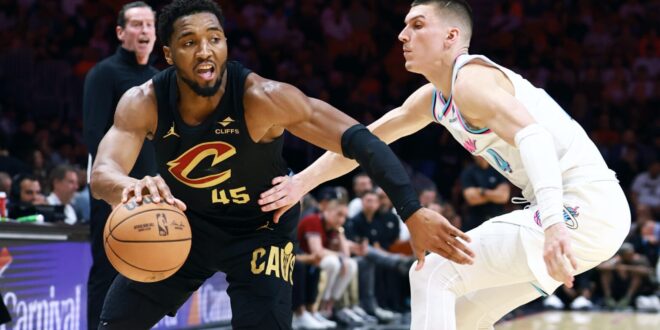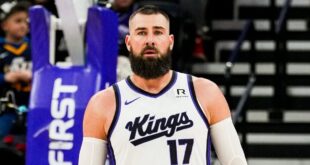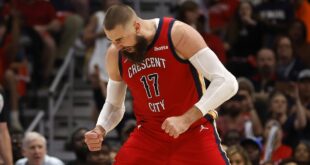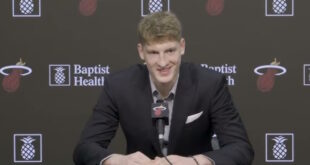**• Get the NBA App**
Right from the start, the Cleveland Cavaliers established themselves as the premier team in the Eastern Conference, achieving a remarkable 15-game winning streak, along with two additional winning streaks of at least 12 games, ultimately concluding the season with the second-highest win total in franchise history.
Conversely, the Miami Heat have not been as dominant, yet they remain a tenacious team that refuses to fade away. They successfully secured two victories on the road during the SoFi NBA Play-In Tournament to reach this point, displaying the same determination that propelled them from the Play-In to the Finals two years earlier. In fact, this year’s squad performed statistically better than that previous iteration; while the 2022-23 Heat faced an overall deficit in scoring during the regular season, this group’s point differential mirrored that of a 43-39 team, despite grappling with challenging finishes in close contests.
The Cavaliers triumphed in two out of three encounters during the regular season and will enter the series with ample rest when play begins on Sunday night, but this matchup against the Heat is likely the last scenario the Cavs desired from the four Play-In teams.
Here’s how you can watch the Cavaliers and Heat face off:
All times are in Eastern Standard Time.
* = If required.
With their advancement out of the SoFi Play-In Tournament, the Heat now take on the top-seeded Cavaliers in the first round.
**The Cavaliers’ Offense:** Cleveland boasted the second most efficient offense in NBA history, scoring 121.0 points per 100 possessions. They finished second in both field goal percentage in the paint (60.7%) and three-point shooting (38.3%), featuring a league-high eight players who shot at least the league average (36.0%) on a minimum of 200 three-point attempts. Additionally, they ranked fourth in turnover rate, experiencing the fourth-most significant improvement from the previous season.
Last year, the Cavs witnessed a notable decline from their regular season point average of 114.7 (16th place) to 104.7 during the playoffs (14th place out of 16). They struggled with a dismal 35.5% shooting percentage from mid-range and a 31.5% success rate from three-point territory across their 12 postseason games, also seeing a substantial drop in free throw rate.
This iteration of the offense differs markedly, as the Cavaliers have increased their pace and significantly enhanced both ball and player movement this season. Meanwhile, the Heat have maintained a top-10 defense for the sixth consecutive year, allowing only 101.0 points per 100 possessions in their two Play-In games.
**Guarding Tyler Herro:** On the defensive end, the Cavs will need to focus on Tyler Herro, who leads the Heat in time of possession, usage rate, scoring, and assists. Herro notched 34 points and seven assists during Miami’s nine-point victory over Cleveland in December.
Max Strus is likely to be the primary defender assigned to Herro. In the regular season, Herro did not frequently target Cleveland’s guards, Darius Garland and Donovan Mitchell, during ball-screen plays, based on data from Second Spectrum. The Heat will primarily utilize their big men to set screens, and we can anticipate center Jarrett Allen implementing “drop” coverage to protect the rim in the Cavs’ primary defense. Should Herro be effective from the perimeter, adjustments may be necessary.
Making adjustments could draw the Cavs’ bigs away from the basket, potentially impacting their rebounding efforts.
**For Cleveland: Rebounding Concerns.** Two seasons ago, the Cavaliers faced significant challenges on the boards, leading to their elimination by the Knicks in the first round. Last year, they recorded the lowest rebounding percentage during the conference semifinals.
During the regular season, the Cavs ranked 22nd in defensive rebounding percentage, experiencing the fifth-largest drop in the league compared to the previous year. Although the Heat ranked a mere 27th in offensive rebounding percentage (26.3%), they made significant tip-ins during their overtime victory against Atlanta on Friday, and registered second-chance points favorably (19-10) in their earlier win over Cleveland in December.
Field goal percentages tend to decrease in playoffs, resulting in more missed shots and additional rebound opportunities. Therefore, the capability to dominate the boards will be under close scrutiny in the coming months.
**For Miami: Contributions from Secondary Scorers.** Herro will need support from his teammates, as relying solely on him to match the Cavs’ scoring will not suffice. Davion Mitchell emerged as an unexpected offensive contributor (31 points total) across the two Play-In games, while Bam Adebayo’s ability to hit jump shots will be crucial.
Adebayo took 36% of his shots, the highest percentage of his career, from outside the paint. When sharing the floor with rookie Kel’el Ware, he may find himself more spaced out, with Cleveland’s bigs likely preferring to guard him close to the basket.
**14.6%**—This marks the third consecutive season in which the Heat utilized zone defense most frequently, doing so on 14.6% of defensive possessions, according to Synergy tracking.
While they only employed zone defense on three occasions during their Play-In games, it was prevalent in all three regular-season matchups against the Cavs. Cleveland encountered the second-fewest zone possessions this season, but nearly half of them (72 out of 150) occurred against Miami. Although they did not score as efficiently against the zone overall, the Cavs performed better against Miami’s zone than against the league average.
Interestingly, Cleveland was third in the league with zone defense used for 8.6% of their defensive possessions, suggesting that we can expect to see both teams implement zone strategies throughout this series.
**Cavs in Five.** With their two victories in the Play-In, the Heat have now claimed six of their last seven road games. They are a resilient squad capable of creating challenges for any competitor.
However, the Cavaliers possess a more robust defense and a wider array of offensive options than the two teams the Heat previously bested. Additionally, despite the Heat’s ninth-ranked overall defense, they ranked 19th when facing the league’s top 10 offenses (allowing 118.8 points per 100 possessions).
This Cavaliers team is among the best offensive units seen in recent history, and they should secure a spot in the conference semifinals for the second consecutive year.
* * *
John Schuhmann serves as a senior stats analyst for NBA.com. You can email him here, browse his archive here, and follow him on X.
The opinions expressed here do not necessarily reflect those of the NBA, its franchises, or Warner Bros. Discovery.
 NBA News NBA News, Match Reports and Updates
NBA News NBA News, Match Reports and Updates



